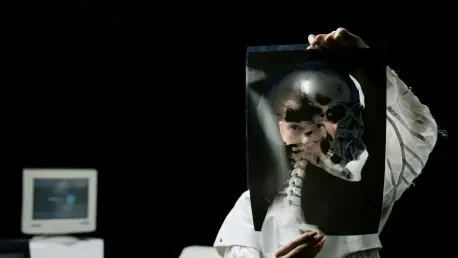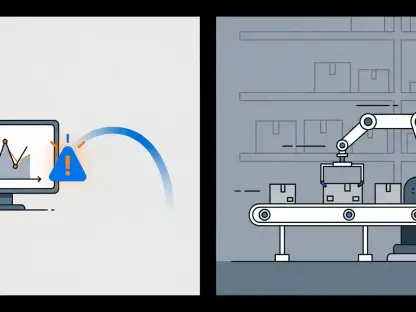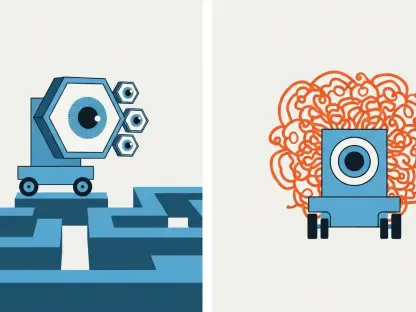In the fast-paced realm of healthcare technology, a remarkable breakthrough is turning heads with its potential to redefine medical imaging through artificial intelligence, promising to make diagnostics more accessible. Researchers at the University of California San Diego (UC San Diego) have unveiled a pioneering AI tool that dramatically cuts down the data needed for accurate medical image segmentation—a process vital for pinpointing diseases at a pixel level. Traditionally, the dependency on vast annotated datasets has stymied progress in AI-driven diagnostics, especially in settings where resources are scarce. This innovation, however, offers a glimmer of hope by making advanced diagnostic capabilities more accessible to clinics and regions that previously couldn’t afford such technology. Detailed in a recent publication in Nature Communications, this development could usher in an era of earlier disease detection and improved patient outcomes. The implications are profound, promising to bridge gaps in healthcare equity while enhancing efficiency across the board.
Breaking Through the Barrier of Data Scarcity
The challenge of data scarcity has long hindered the adoption of AI in medical imaging, creating a significant obstacle for leveraging deep learning in diagnostics. Conventional models for image segmentation, which label each pixel to differentiate between healthy and diseased tissue, demand extensive datasets of annotated images. Compiling these datasets is not only labor-intensive but also costly, often requiring countless hours from skilled radiologists or specialists. In environments where expertise or funding is limited—such as for rare conditions or in small clinics—this requirement renders AI solutions nearly unattainable. The result is a stark disparity in access to cutting-edge diagnostic tools, leaving many healthcare providers unable to harness the benefits of modern technology for their patients.
Enter the groundbreaking work by the UC San Diego team, spearheaded by Professor Pengtao Xie and Ph.D. student Li Zhang, which slashes the data needed by up to 20 times compared to traditional methods. Their innovative AI tool employs generative AI to produce synthetic images and segmentation masks, effectively supplementing the sparse real-world data available. This approach means that instead of requiring thousands of labeled images, a robust model can now be trained with just a small fraction of that amount. By dismantling this long-standing barrier, the technology paves the way for broader implementation of AI diagnostics, ensuring that even under-resourced settings can tap into sophisticated tools for better patient care.
Unpacking the Mechanics of Generative AI Innovation
At the core of this transformative AI tool lies a generative framework that crafts realistic synthetic images from segmentation masks—visual overlays that distinguish tissue types through color coding. These artificially created images are combined with a minimal set of real annotated examples to form a comprehensive training dataset for segmentation models. What makes this system stand out is its integrated feedback loop, which continuously evaluates and refines the synthetic data based on their impact on the model’s accuracy. This dynamic process ensures that the generated content is not only lifelike but also specifically tailored to enhance diagnostic precision, marking a significant leap from older methods where data creation and model training operated in isolation.
The efficiency of this technology translates into tangible benefits for real-world applications, particularly in scenarios with limited data. Unlike traditional deep learning approaches, this tool achieves superior performance—outperforming conventional methods by 10 to 20 percent in low-data environments. For instance, a healthcare provider could train a model to detect abnormalities like skin lesions using just a handful of labeled images, enabling near-instantaneous analysis during patient consultations. This capability not only saves valuable time but also boosts diagnostic accuracy, potentially leading to earlier interventions that could be life-saving in critical cases. The seamless integration of synthetic data generation with model training redefines what’s possible in medical imaging.
Transforming Diagnostics Across Diverse Medical Fields
One of the most compelling aspects of this AI tool is its remarkable versatility, demonstrated through successful testing across a wide spectrum of medical imaging tasks. From identifying skin cancer in dermoscopy scans to detecting breast cancer in ultrasound images, the tool adapts effortlessly to various diagnostic needs. It also excels in locating placental vessels in fetoscopic visuals, spotting polyps during colonoscopies, evaluating foot ulcers in standard photographs, and even mapping complex 3D anatomical structures such as the hippocampus or liver. This adaptability positions the technology as an invaluable resource for multiple medical specialties, addressing a broad range of health concerns with a single, unified approach that reduces dependency on extensive data collection.
By significantly lowering the data threshold for effective AI training, this innovation empowers healthcare providers to adopt advanced diagnostics for both prevalent and uncommon conditions. Consider a small dermatology practice or a hospital in a developing region—previously, such facilities might have struggled to compile enough annotated images to utilize AI tools effectively. Now, with minimal input, accurate models can be developed to enhance disease detection and management. The potential impact is transformative, enabling timely and precise interventions that could save lives and improve patient outcomes. This technology democratizes access to high-level diagnostics, ensuring that resource constraints no longer dictate the quality of care available.
Future Horizons for AI in Healthcare
Looking ahead, the UC San Diego research team is committed to refining this AI tool by incorporating direct feedback from clinicians to align it more closely with real-world clinical demands. This iterative process aims to enhance the relevance and accuracy of the synthetic data generated, ensuring that the technology meets the nuanced needs of healthcare professionals in diverse settings. As these improvements unfold over the coming years, the tool could become a cornerstone of medical diagnostics, streamlining workflows and enabling earlier disease detection even in the most challenging environments. The focus on practical applicability signals a shift toward more inclusive healthcare solutions that prioritize accessibility alongside innovation.
Reflecting on the strides made, this development tackled a persistent challenge in healthcare AI by reducing data requirements while boosting performance in low-data scenarios. Its ability to adapt across various imaging tasks underscored a versatility that reshaped diagnostic capabilities. As refinements progressed, collaborations with medical practitioners ensured that the technology remained grounded in clinical reality. The journey of this AI tool highlighted a pivotal moment in healthcare, demonstrating how technological advancements bridged critical gaps in data availability and expertise, ultimately fostering a landscape where equitable and efficient medical care became a tangible achievement for many.









